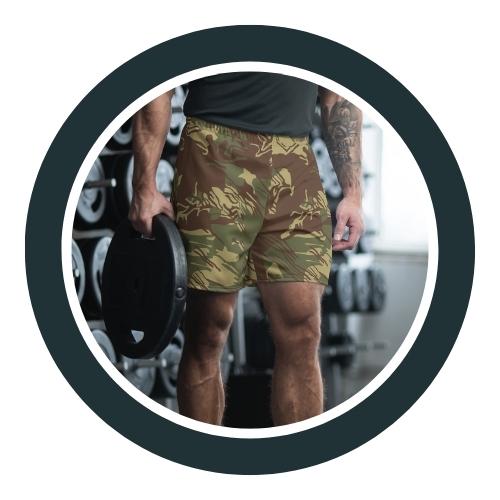Collection: German WW2 Ambush Three Stripe Tank CAMO
At the start of the conflict, Germans used very simple patterns of camouflage. All vehicles were painted in gray Panzergrau color (RAL 7021). With experience gained on battlefields across the Europe, it became clear that additional camouflage would be necessary. At first, tank crews used... mud, to “paint irregular spots on the armor. Then, additional brown and green paints were used.
Through the war, the gray and extemporary proved itself to be insufficient. Especially on the eastern front, gray silhouettes of tanks were way too easy target for Soviet gun crews. In 1942, and officially in instructions from 1943, new base paint for German armor was used as base color. It was dark yellow Dunkelgelb (RAL 7028). Subsequently, the armour of tanks was painted with irregular spots, streaks and lines with two additional colors: dark green Olivegrün (RAL 6003) and dark brown Rotbraun (RAL8017). During spring-summer period camo colors were mostly green, during fall camo were more brownish. There were situations when the much-needed equipment was sent to first line units before painting the camouflage. In that case, the vehicle went to fight only painted only with the base, dark yellow color. pomalowany jedynie kolorem podstawowym. There were also more complicated types of camouflage, using additional dark green and dark brown colors. Those camo patterns were called “Ambush” and “Splinter”. First one was a variation of spots camouflage. The difference were extra dots, or small spots painted on basic type camo, green and brown on yellow, brown and yellow on green and green and yellow on brown. The second one, the “Splinter” was easier to make, by painting regular stripes, or geometrical shapes with sharp edges.
-
German WW2 Ambush Three Stripe Tank CAMO Unisex Bomber Jacket
Regular price €64,95Regular priceUnit price / per -
German WW2 Ambush Three Stripe Tank CAMO Duffle bag
Regular price €64,95Regular priceUnit price / per -
German WW2 Ambush Three Stripe Tank CAMO Unisex zip hoodie
Regular price €60,95Regular priceUnit price / per -
German WW2 Ambush Three Stripe Tank CAMO Men’s high top canvas shoes
Regular price €57,95Regular priceUnit price / per -
German WW2 Ambush Three Stripe Tank CAMO Men’s windbreaker
Regular price €57,95Regular priceUnit price / per -
German WW2 Ambush Three Stripe Tank CAMO Unisex Hoodie
Regular price €55,95Regular priceUnit price / per -
German WW2 Ambush Three Stripe Tank CAMO gym bag
Regular price €53,95Regular priceUnit price / per -
German WW2 Ambush Three Stripe Tank CAMO Men’s Joggers
Regular price €50,95Regular priceUnit price / per -
German WW2 Ambush Three Stripe Tank CAMO Yoga mat
Regular price €50,95Regular priceUnit price / per -
German WW2 Ambush Three Stripe Tank CAMO Unisex button shirt
Regular price €46,95Regular priceUnit price / per -
German WW2 Ambush Three Stripe Tank CAMO Unisex track pants
Regular price €45,95Regular priceUnit price / per -
German WW2 Ambush Three Stripe Tank CAMO unisex wide-leg pants
Regular price €45,95Regular priceUnit price / per -
German WW2 Ambush Three Stripe Tank CAMO Men’s Leggings
Regular price €45,95Regular priceUnit price / per -
German WW2 Ambush Three Stripe Tank CAMO Men’s Rash Guard
Regular price €45,95Regular priceUnit price / per -
German WW2 Ambush Three Stripe Tank CAMO Backpack
Regular price €44,95Regular priceUnit price / per -
German WW2 Ambush Three Stripe Tank CAMO hockey fan jersey
Regular price €42,95Regular priceUnit price / per -
German WW2 Ambush Three Stripe Tank CAMO Longline sports bra
Regular price €41,95Regular priceUnit price / per -
German WW2 Ambush Three Stripe Tank CAMO Women’s Leggings with pockets
Regular price €39,95Regular priceUnit price / per -
German WW2 Ambush Three Stripe Tank CAMO unisex sports jersey
Regular price €36,95Regular priceUnit price / per -
German WW2 Ambush Three Stripe Tank CAMO Sherpa blanket
Regular price From €36,95Regular priceUnit price / per -
German WW2 Ambush Three Stripe Tank CAMO Men’s Athletic T-shirt
Regular price €36,95Regular priceUnit price / per -
German WW2 Ambush Three Stripe Tank CAMO T-shirt dress
Regular price €36,95Regular priceUnit price / per -
German WW2 Ambush Three Stripe Tank CAMO Unisex Sweatshirt
Regular price €36,95Regular priceUnit price / per -
German WW2 Ambush Three Stripe Tank CAMO Men’s Athletic Shorts
Regular price €36,95Regular priceUnit price / per

























